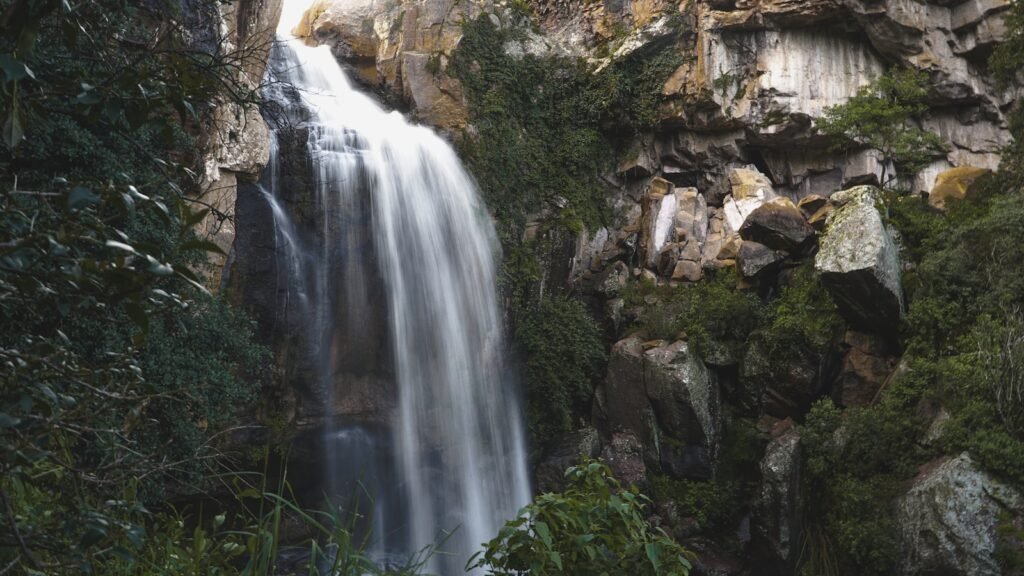Locals call it a miracle, tourists call it a trick, and geologists call it by a name that sounds almost magical: travertine. In parts of Mexico where limestone mountains leak mineral-rich springs, fallen branches don’t just rot away – they slowly harden under creamy mineral coats until they look like fossils fresh from a museum shelf. The scene is disarming: a living stream draping the landscape with slices of pale rock, as if time itself spilled over the banks. What seems like alchemy is really chemistry, biology, and physics working together, fast enough for human eyes to notice.
The Hidden Clues

Start by looking at the water itself. It often appears slightly milky or turquoise, a hint that tiny crystals are already forming and scattering the light. The stones wear soft, chalky edges rather than sharp ones, and submerged twigs feel crusty instead of slimy – early signs of mineral coating.
Along the banks, you can sometimes spot delicate “shells” of stone where a leaf or twig used to be, the organic matter long gone, the mineral mold left behind. That shell is mostly calcium carbonate, the same stuff as seashells and cave stalactites. Here, though, it builds in open air, on the move, as the stream tumbles downhill.
Mexico’s Living Waterfalls

Mexico’s karst country, especially in the central and southern highlands, is primed for this phenomenon because groundwater flows through vast beds of limestone. Those rocks dissolve slowly, loading spring water with calcium and dissolved carbon. When those springs reach the surface and rush into sunlight and warm air, the chemistry tips and solid stone begins to fall out of the water.
Places famous for “petrified” landscapes – like the striking white cascades locals call petrified waterfalls – form over long stretches of time through the same mechanism. In shaded reaches, a branch snagged by the current becomes a scaffold for the process, getting coated first in a thin, brittle rind, then in thicker layers that survive even if the wood decays. The result looks like a river making its own fossils in real time.
The Chemistry Beneath the Shine

Calcium carbonate starts out hidden, traveling as dissolved bicarbonate in cool, pressurized groundwater. At the surface, the water loses carbon dioxide to the air, its pH nudges upward, and the balance shifts toward solid carbonate crystals. Stirring and splashing speed things up by exposing more water to the air, so rapids and cascades tend to crust faster than quiet pools.
Temperature matters too, because warmer water holds less carbon dioxide and favors precipitation. With the right push, crystals begin to nucleate on anything available: sand grains, leaves, or the fuzzy films that naturally coat submerged surfaces. Over days to weeks, a translucent skin can form; over months to years, that skin thickens into durable stone.
Life Builds the Stone

It’s not just chemistry; the river is full of tiny helpers. Microbial biofilms – natural mats of bacteria and algae – act like sticky nets that trap ions and particles, giving crystals a place to start. These films also tweak the micro-chemistry right at the surface, nudging pH and carbon dioxide in ways that favor crystal growth.
Under a microscope, the story gets even better: you see needle-like crystals, tiny fans, and layers that record daily rhythms of flow and light. Over time, the rock preserves these textures like a diary. That’s why the final stone sometimes looks velvet-smooth in one layer and sugar-grained in the next.
From Ancient Tools to Modern Science

Humans have noticed this trick for millennia. Ancient builders quarried travertine for temples and amphitheaters because it was plentiful and surprisingly strong. The same fast-growing stone that coats twigs once faced the façades of empires.
Today, researchers use portable sensors to track pH, alkalinity, and dissolved carbon in the field, then pair those snapshots with lab analyses that read subtle isotope fingerprints. Drones map terraces in fine detail, while time-lapse cameras catch seasonal shifts in flow and color. The more we measure, the clearer the pattern: fast water, high calcium, and steady degassing build stone at a pace you can feel under your fingertips.
Why It Matters

These rivers do more than create scenery; they store carbon, filter water, and archive environmental change. As calcium carbonate forms, it locks away carbon from the water, and indirectly from the air, in layers that can last centuries. Those same layers trap pollen, dust, and microscopic life, leaving clues to past droughts, floods, and ecosystem shifts.
There’s a practical angle too. The conditions that encourage “stone rivers” can also clog irrigation pipes and springs, complicating local water use. Understanding when and where deposition accelerates helps communities plan, manage infrastructure, and protect fragile formations beloved by visitors. It’s a natural laboratory with real-world stakes.
The Future Landscape

Climate pressures are already nudging these systems. Warmer air, altered rainfall, and changing groundwater levels can speed up or slow down mineral deposition, shifting where stone grows and where it erodes. If drought lowers spring discharge, a once-vigorous terrace can go quiet; if a storm scours the channel, fresh surfaces invite a burst of new growth.
Researchers are testing low-cost sensor networks to watch these rivers in near real time and catch tipping points before they reshape a whole valley. Community science – simple measurements of temperature, pH, and flow – could help fill gaps across remote stretches. The goal is not to freeze landscapes in place, but to understand their pulse well enough to keep them healthy as the climate turns the dial.
The Hidden Costs of Touch

There’s a reason many sites now ask visitors not to walk on terraces or pry off the crust that forms on branches. Fresh layers are surprisingly delicate, and a single bootprint can crush months of growth. Sunscreens and lotions can also interfere with the biofilms that seed new crystals, adding an unseen stress to already sensitive systems.
When a formation breaks, the river has to start again from scratch, and the new stone may grow differently if flow patterns change. Small disturbances multiply over a busy season, and the damage often shows up after the crowds are gone. Respecting the process is part of letting the science – and the beauty – do its quiet work.
Conclusion

If you find yourself at one of these calcium-rich springs, treat it like a living museum piece. Stay on marked paths, don’t peel off “souvenirs,” and keep soaps and creams out of the water. If you live nearby, consider joining local monitoring groups to log simple readings or report sudden changes in clarity or flow.
Teachers and parents can turn a visit into a hands-on chemistry lesson: watch for the milky tint, feel the chalky textures, and sketch how a twig becomes a stone cast. A few careful choices from each of us help keep these rivers writing their story in stone – layer by layer. Would you have guessed that a twig and a trickle could sculpt a cliff?

Suhail Ahmed is a passionate digital professional and nature enthusiast with over 8 years of experience in content strategy, SEO, web development, and digital operations. Alongside his freelance journey, Suhail actively contributes to nature and wildlife platforms like Discover Wildlife, where he channels his curiosity for the planet into engaging, educational storytelling.
With a strong background in managing digital ecosystems — from ecommerce stores and WordPress websites to social media and automation — Suhail merges technical precision with creative insight. His content reflects a rare balance: SEO-friendly yet deeply human, data-informed yet emotionally resonant.
Driven by a love for discovery and storytelling, Suhail believes in using digital platforms to amplify causes that matter — especially those protecting Earth’s biodiversity and inspiring sustainable living. Whether he’s managing online projects or crafting wildlife content, his goal remains the same: to inform, inspire, and leave a positive digital footprint.




